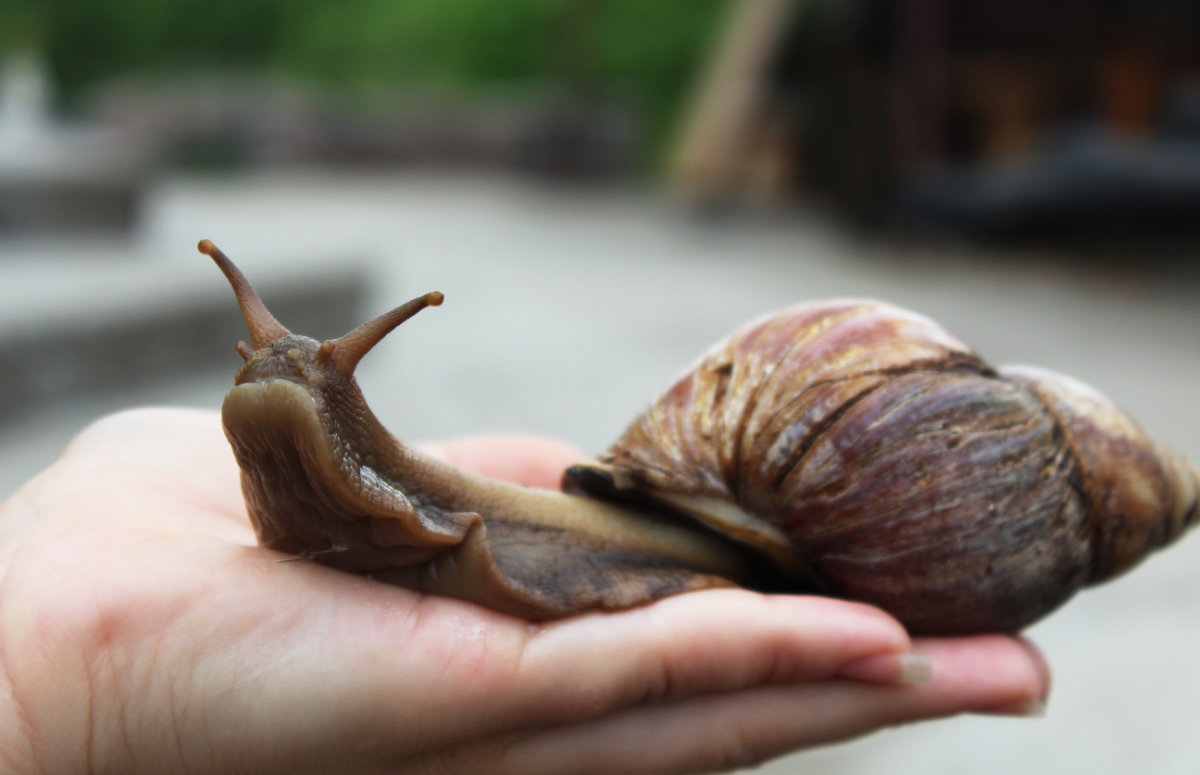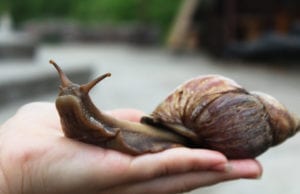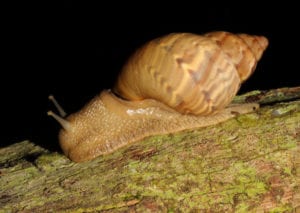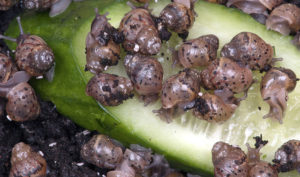
Giant African Land Snail – Achatina achatina
Anyone looking for an unusual but still low-maintenance pet that is suitable even for young children could do a lot worse than opting for a Giant African Land Snail. There are several species found in the pet trade but the Giant Ghana African Snail or Giant Tiger Land Snail (Achatina achatina) is the one most frequently encountered.
The general feeding and husbandry of all species are much the same, and all species can live for several years. They generally grow to between 17 & 20cm in length (7 – 8 Inches) although larger ones have been recorded. Thus you will need suitable accommodation for them.

They are not called Giant Land Snails for nothing! Baboshkina Yevheniia/Shutterstock
In the Wild
Achatina achatina are native to Ghana, Nigeria, Sierra Leone, and various other countries along Africa’s West Coast. They are also found in Martinique, although this was probably by accidental introduction. They are classed as invasive species in most countries so never let them get into the wild or you could be facing a heavy fine.
By and large they are nocturnal in the wild and this habit has been maintained in captive bred individuals. Virtually all the ones offered by the pet trade are captive bred nowadays so sit up late if you want to see them in action.

Giant Ghana African Snail. Image: Judith Lienert/Shutterstock
Housing a Giant African Land Snail
The best home for a Giant Land Snail is a small glass or plastic aquarium-style tank as these are easy to clean and you will be able to watch your snails through the sides. It will need a tight-fitting lid as snails like to go walkabout. The tank doesn’t need to be big but given they will grow to 7-8 Inches an 18″ to 24″ one should be considered the minimum, and bigger if you are keeping more than one.
Keep Them Out Of The Sun
Site the tank out of direct sunlight and away from anywhere where it could come into contact with household chemicals (including fly spray). Too much sun will cause sudden temperature spikes which will do your snail no good at all. Land Snails also like to burrow, so fill the tank with a few inches of peat-free compost. You can also add leaf litter and moss to add interest both from an ascetic viewpoint and for your snail to enjoy. They also enjoy having a large piece of tree bark in their tank. This is multi purpose giving something to hide under and crawl over.
Make sure that this substrate is kept moist, but not soggy at all times, and change parts of this substrate periodically. Temperature-wise 20-25°C is ideal and use a heat mat or pad to maintain this. Provide them with a decent size bowl of water (which needs changing regularly) and voila you will have happy snails.
Hibernation Issues
If your snails are not kept in correct conditions they may go into hibernation known as “aestivating” by sealing itself into its shell by secretion of a calcerous compound that dries on contact with the air. Should this happens you are keeping the snails incorrectly so check the above and remedy. Fortunately, once you resolve the issues you can encourage the snails to open up again by bathing them in luke-warm water.
Feeding
All African Land Snail species are very easy to feed, as they will eat most plant species. The best food though is lettuce and cucumber but apple, banana and cabbage and other is Brassica’s can also be given. They also benefit from small amounts of protein such as boiled egg or even plain mince. However, if you give your snails food that goes off quickly (such as egg, banana and apple) be sure to remove it when it has gone brown. In the case of egg take it out after a few hours so as not to make your snails ill.
Minerals are vital
An essential part of the snails’ diet is calcium and is used to keep their shells strong and healthy. This Calcium can be provided in various forms with a cuttlefish bone being the most practical and cost-effective. However, you can also get proprietary pre-mixed calcifying foods which usually comprise a blend of Calcium Carbonate, Oyster Shell flakes & ground Cuttlefish Bone.
Breeding Giant African Land Snails
Breeding Achatina achatina is not rocket science and if you keep two or more together and feed and house them correctly, you are going to get babies! Like most snail species Giant Land Snails are hermaphrodites, meaning that one snail is simultaneously both male and female and you don’t even need to have a pair as they can potentially self fertilize (although this is rare).
The eggs are carried on the adult until they hatch and at this stage, you should move the babies to a separate tank to avoid them being accidentally damaged. A separate tank is ideal but a large Tupperware style tub will suffice short term. Make sure you punch plenty of air holes in the lid.

Baby Land Snails look cute, but bear in mind they will grow fast and need homes!
Image: Helga Lei/Shutterstock.com
They can start breeding at around 22 months old and a well-grown healthy Achatina achatina usually lays between 6 & 30 eggs at a time. These take at least 3 weeks to hatch. In captivity where there is no natural predation 80-90% of these could end up reaching maturity. Given this, we wouldn’t advocate deliberately setting out to breed Giant African Land Snails unless you have homes waiting for them.
Legalities
It is legal to own and keep Giant African Land Snails within the UK and most of Europe. However it is illegal to release them or their eggs into the wild. In the USA you will need to check state and federal regulations. Here Giant African Land Snails are considered to be an invasive species that could significantly affect the ecosystem.
Buying One
They can often be bought from pet shops that specialise in exotic pets, or sometimes bought directly from specialist breeders online. Because they are relatively easy to breed in captivity, you should only buy captive-bred snails rather than ones imported from the wild. This also minimises the already limited risk of parasites, however, you should take reasonable precautions including thoroughly washing your hands after handling them or cleaning them out. For those wanting to know more about this, there is a good scientific paper available here.
Eating One
OK this may seem like an odd topic to end with but in many countries (particularly those in western Africa) they are considered something of a delicacy. Although we have not tried them we have been informed that they have a texture similar to calamari.
If you do decide to eat one make sure that it is cooked properly. Also unlike smaller snail species they will need cleaning. Snails are an increasingly popular food and commercial farming of the various edible species is becoming more mainstream. You can read a bit more about commercial snail farming here.
So there we have it a quick guide to these fascinating if not overly active pets. They are easy to keep and make a good talking point if ever asked if you have a pet.
Got a few more minutes then why not check out some of our other unusual pet articles such as our quick guide to Moray Eels, or take our Giant Land Snail Quiz.